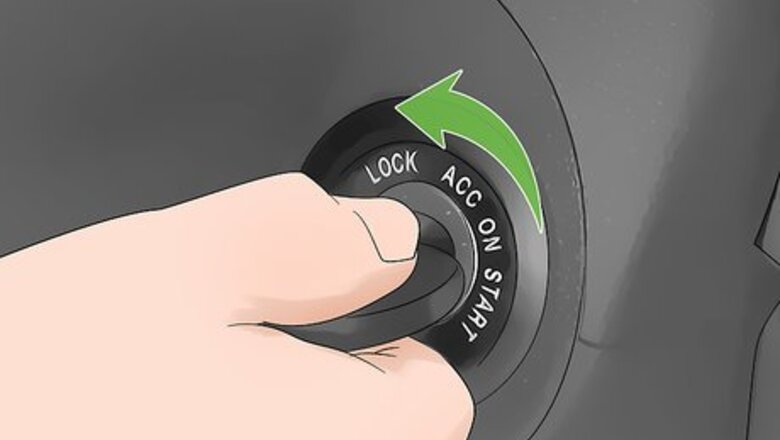
views
Removing the Steering Wheel

Take out the key and turn the steering wheel counterclockwise to lock it. It’s important that you cut off all power to any of the controls in your steering wheel before you take it off so you don’t risk shocking yourself. Turn off your vehicle and remove the key from the ignition so it’s not drawing any power from your battery. Then, turn your steering wheel counterclockwise, or to the left, until you hear it click so it’s locked into place. Locking the steering wheel will make it easier to remove and find the right alignment so you can reinstall it correctly.

Disconnect the battery and wait 10 minutes to deactivate the airbag. Removing all electricity from your vehicle will make sure your airbag won’t accidentally deploy when you try to remove it. Pop the hood and find your car’s battery. Use a wrench to loosen the screw and remove the cable from the negative terminal first, which will have a negative symbol (-) next to it. Then, remove the cable from the positive terminal, which will have a plus sign (+) next to it. Wait about 10 seconds for the power to drain from your airbag. Oftentimes the negative terminal will have a black covering and the positive terminal will have a red covering that you need to lift in order to access the terminals. Don’t remove the screw holding the cables to the terminals. Just loosen them enough for you to slide them off.
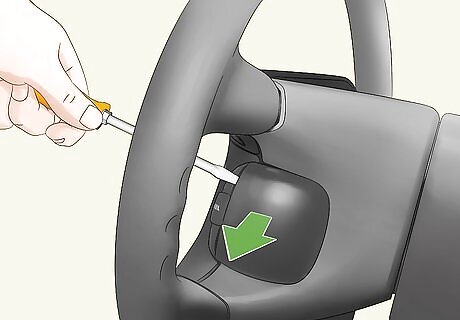
Pop off the trim pieces on the steering wheel with a screwdriver. The trim of your vehicle covers and protects the bolts that attach your steering wheel. Look for 2 small coverings in the trim on either the sides or the top and bottom of your steering wheel. Take a flathead screwdriver and wedge it into the crease of the trim pieces and pop them off to expose the bolts underneath. The location of the trim pieces varies based on the make and model of your vehicle.

Use a socket wrench to remove the bolts beneath the trim pieces. Attach a socket that fits the bolts to your wrench. Fit the socket over 1 of the bolts and start rotating it counterclockwise to unscrew it. Continue unscrewing the bolt until you can remove it by hand. Then, remove the other bolt the same way. Some vehicles may have bolts that fit a star bit, which you can attach to your socket wrench to remove.
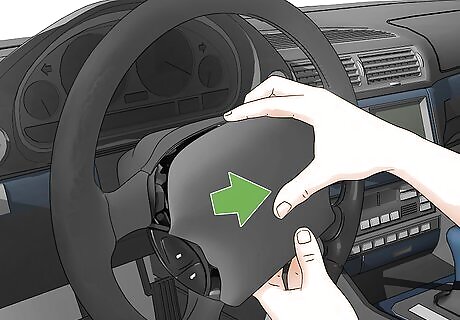
Pull out the airbag and unclip the wiring harness to remove it. With the bolts removed, the airbag will be loose enough to be pulled out of the center of the steering wheel, but there are still wires connected to it, so don’t pull it all of the way out. Use your hands to gently pull the airbag from your steering wheel until you can see the wiring beneath it. Then, locate the harness on the back of the airbag and carefully disconnect them to remove the airbag. Set the airbag aside so you can reinstall it later.Warning: Don’t yank or rip off the airbag or it could potentially go off and cause serious injury.
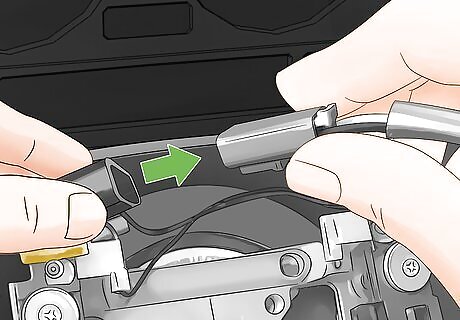
Disconnect any wire harnesses on the steering wheel. If your vehicle has cruise control or extra controls on your steering wheel, there will be additional wires on your steering wheel that need to be disconnected. Find the harnesses that the wires are connected to and gently pull them apart so they’re separated. Some wire harnesses may have a tab or button that you need to press in order to pull them apart.

Unscrew the bolt from the center of the steering wheel. Locate the large bolt in the center of the steering wheel. Attach a wrench to it and turn it counterclockwise to loosen it. Continue unscrewing the bolt until you can remove it by hand and set it aside.

Make an alignment marking if there isn’t one on the steering wheel. It’s super important that you align the steering wheel correctly when you reinstall it. On the slot where you removed the center bolt, look for 2 markings where the steering wheel and shaft meet that are lined up to indicate the correct orientation of the steering wheel. If there aren’t 2 markings, take a marker and draw a small line over where the steering wheel and the shaft connect. Knowing the proper alignment is crucial to reinstalling the steering wheel correctly.
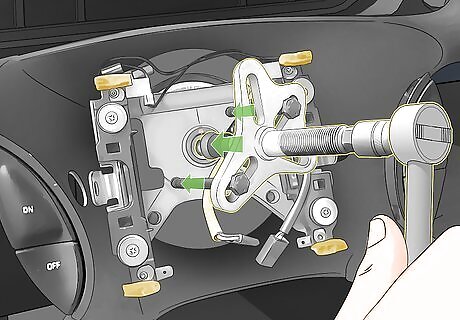
Attach a puller if there are slots on the steering wheel. Some steering wheels can only be removed with a specialized tool called a puller. If your steering wheel has 2 slots on each side of the shaft, then you’ll need to use a puller to remove it. Fit the puller over the center of the steering wheel and insert both of the long puller screws into the 2 slots. Tighten them by hand so they’re firmly attached. You can find pullers at hardware stores and online.Note: If your steering wheel doesn’t have slots for a puller, then you don’t need to use one to remove it. Just take a firm grip on the steering wheel with your hands and pull it off of the shaft.
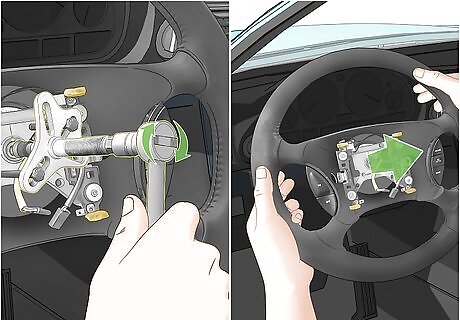
Tighten the puller with a socket wrench and pull off the steering wheel. Fit a socket wrench over the bolt on the puller and start cranking it to tighten it. Continue tightening the puller until the steering wheel separates from the shaft. Then, use your hands to take off the steering wheel and unscrew the puller to remove it.
Stripping and Cleaning the Wheel

Cut the threads along the seam with a utility knife. Locate the seam where the leather is sewn over the steering wheel. Use a utility knife to carefully cut along the threads to separate them. Continue cutting all along the steering wheel until all of the threads are cut. Try to be as neat as you can so you can use the old leather as a template.
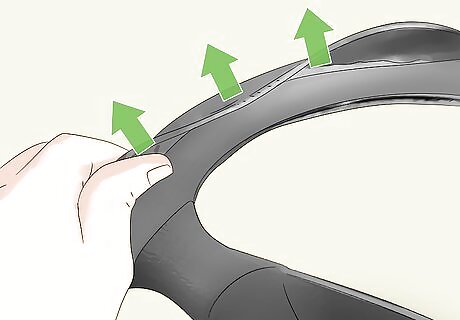
Peel off the old cover with your hands. Use your fingers to pry up the old leather beneath the seams that you cut. Peel back the leather material carefully so it doesn’t rip or tear. Work around the entire steering wheel to peel off the leather. Carefully peeling off the leather will also make the steering wheel easier to clean.
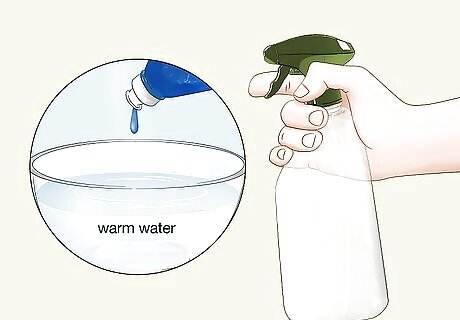
Mix together warm water and dish soap in a spray bottle. Make a simple cleaning solution that won’t damage your steering wheel. Take a spray bottle and fill it with about 1 cup (240 mL) of warm water. Add a few drops of a mild dish soap into the water and shake the bottle to combine the mixture and make it nice and soapy. Use warm water to help the soap mix with the water better.
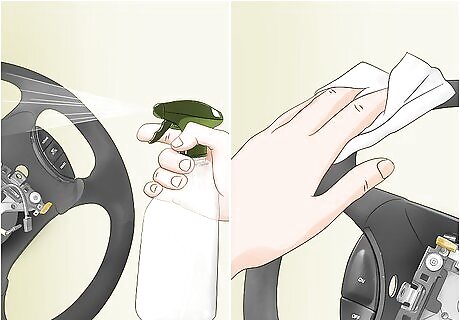
Use the solution to clean off the remaining rubber with a clean cloth. Spray the soap and water over the steering wheel and use a clean cloth to rub away any dirt, grime, or bits of rubber that are attached to it. Use your fingers to peel off any thick pieces of rubber that you can rub off with the cloth.Tip: For stubborn, stuck-on bits of rubber, use a sponge with a scouring pad. Avoid using a wire brush or you could damage the steering wheel.
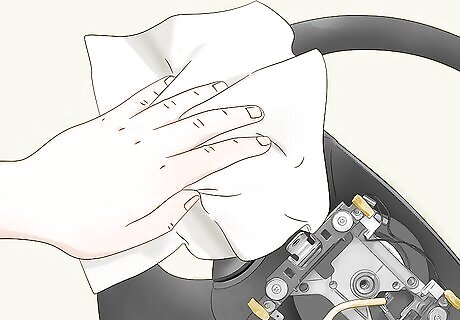
Dry off your steering wheel with a dry cloth. It’s important that the wheel is completely dry before you move on to the next step. Otherwise, your new leather might not stick properly, and you could wind up with mold and an unpleasant smell that ruins all your hard work. Just go over the wheel a few times with a dry cloth until it feels completely dry to the touch.
Trimming and Sewing the New Leather

Trace the outline of the old cover onto the new leather material. The easiest way to cut out a strip of leather that matches the dimensions of your steering wheel is to use the old leather itself. Take your new leather material and lay it on a flat surface so the underside is facing up. Cut your old leather at the seam and stretch it out straight. Place it on top of your new leather material and use a pencil to trace the outline onto the new material. Look for quality leather material at auto body shops, craft supply stores, or by ordering it online.Tip: If the old leather cover is too damaged to use as a template, search online for steering wheel cover template that you can use.

Cut out the pattern from the new leather with scissors. Take a pair of scissors and cut along the lines that you traced. Use smooth and consistent cuts so the new leather doesn’t appear choppy or have jagged edges so it will be easier to sew.
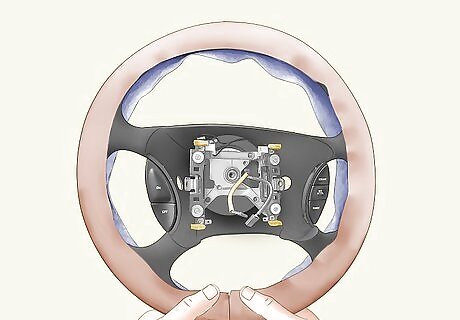
Stretch the new material over the steering wheel to make sure it fits. Take the new leather that you cut and place it on the outside of your steering wheel. Stretch the material and connect the 2 ends to make sure it fits securely around the steering wheel. Then, remove the leather so you can stitch the ends together. If the material is too big or loose, use scissors to trim it so it fits.
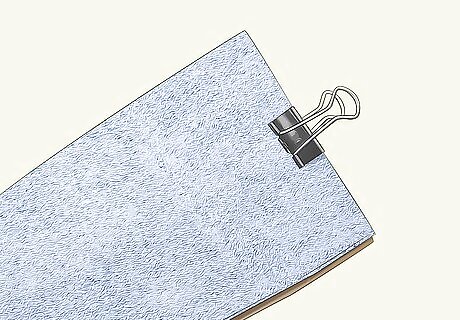
Clip the 2 ends together with a small binder clip. Take the leather strip and hold it so the underside is facing out. Line up the edges of the 2 ends of the leather strip. If they’re uneven, trim the edges with scissors so they line up perfectly. Take a small binder clip and attach it to the ends so they’re held together. You can find binder clips at office supply stores.
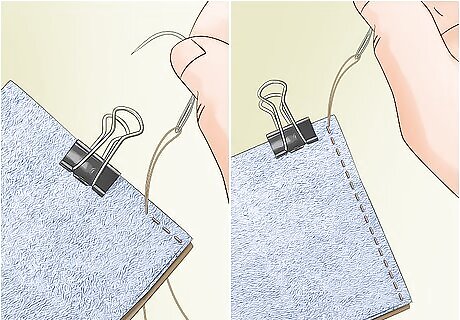
Sew the ends together with nylon thread and a curved sewing needle. Choose nylon thread that closely matches your leather material and thread it through a curved sewing needle. Start at 1 edge and push the needle all the way through the ends of the leather, loop it over, then push it through again. Continue sewing along the ends and tie a knot at the end to secure the stitching. Curved sewing needles work better for sewing leather. Look for nylon thread and curved sewing needles at your local craft supply store or by ordering them online.
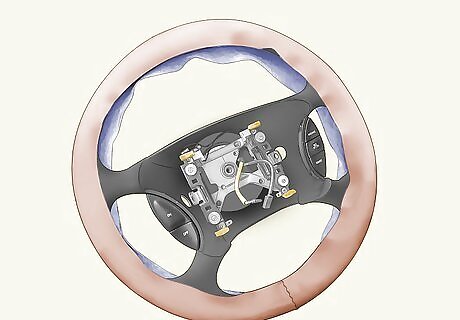
Wrap the new leather over the steering wheel. With the ends connected, take the leather material and stretch it over the steering wheel. Line up the edges of the leather strip so the steering wheel is in the center of the material so you can sew them together evenly. If the material is too loose, remove it from the steering wheel, undo the stitching, trim the edges back, and then sew them together again.
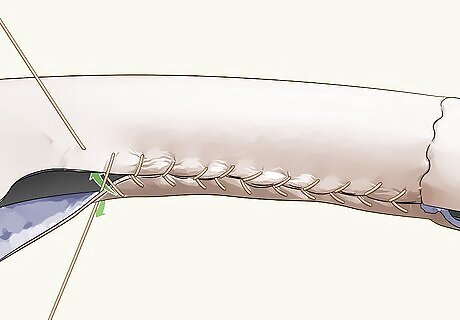
Use 2 curved needles with nylon thread to sew the leather to the steering wheel. Thread 2 curved sewing needles with nylon thread. Start at the edges that you’ve sewn together and push 1 needle through 1 side of the leather and push the other needle through the other side so they’re directly across from each other. Sew the material together by alternating the needles back and forth to form a baseball stitch over the surface of the steering wheel. Pull the thread tight each time you push the needle through the leather. Take your time and insert the needles evenly along the edge of the leather to form a tight and strong stitching. Don’t insert the needles into the steering wheel itself, just the leather material.

Trim the leather around the spokes with scissors. When you reach a spoke on the steering wheel while you’re sewing, use a pair of scissors to trim back the material so it lines up evenly with the edge where the spoke connects to the steering wheel. Then, continue sewing past the spoke until you reach the next one and then trim that one back as well. Continue sewing along the steering wheel and trimming around the spokes until the leather covers the steering wheel.

Glue the leather around the spokes with leather glue to create a seal. Once you’ve finished sewing the leather to the steering wheel, take some leather glue and add a small drop beneath the leather around the spokes. Apply firm pressure for about 10 seconds and then smooth out the material so create a tight seal. If any glue is pushed out from beneath the leather, use a wet cloth to wipe it up immediately so it doesn’t dry. You can find leather glue at department stores or by ordering it online.
Reinstalling the Steering Wheel

Slide the steering wheel back onto the steering shaft. Fit the steering wheel over the shaft so it’s facing up. Thread any wiring through the slots on the steering wheel and push the wheel onto the shaft so the edges are flush. Try to orient the steering wheel so the alignment marking on it is above the shaft.

Plug in any wire harnesses that you disconnected. If your steering wheel has additional wiring for controls, insert the wires into the harnesses that you disconnected them from. Push them until you hear a click so they’re firmly attached.Tip: Make sure the wires are secure by gently tugging on them. You don’t want to have the take the steering wheel back apart to reconnect them!
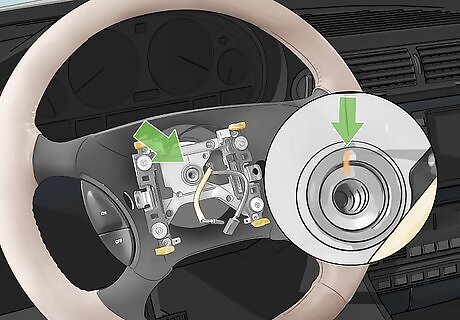
Align the steering wheel with the alignment markings. It’s super important that you align the steering wheel with the shaft so you can install it without any problems. Locate the alignment markings on the wheel and shaft that you either made or were already there. Turn the steering wheel so that the alignment markings perfectly lined up so the steering wheel is oriented correctly.
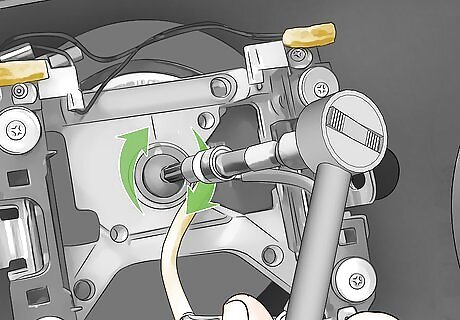
Screw in the center bolt with a socket wrench. Keeping the alignment marks in line, slide the center bolt into the slot and use your hands to rotate it so it’s threaded correctly. Then, take a socket wrench and turn the bolt until it’s as tight as you can make it.

Reattach the airbag to the steering wheel. Locate the wire the powers the airbag and plug it into the harness on the underside of the airbag. Then, slide the airbag into the steering wheel. Replace the airbag bolts on the sides or the top and bottom of the steering wheel so it’s held securely.

Put the trim pieces back over the bolts and reconnect the battery. Take the plastic coverings that you removed to expose the airbag bolts and push them into the slots until they snap into place. Slide the battery cables over the correct terminals and use a wrench to tighten the bolts so they’re held securely.




















Comments
0 comment